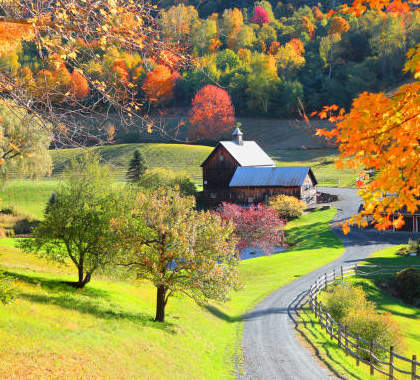Vermont: From Covered Bridges to Maple Syrup
Vermont is a state that encapsulates the quintessential charm of New England. Known as "The Green Mountain State," Vermont's lush landscapes are dominated by the picturesque peaks of the Appalachian Mountains, creating a breathtaking backdrop that transforms with the seasons. This state is not just defined by its iconic maple trees and postcard-worthy villages; it's a place where history, nature and community converge to create a unique way of life. From the vibrant tapestry of fall foliage that paints the countryside in warm hues to the enduring traditions of farming, craftsmanship, and outdoor exploration, Vermont offers a genuine blend of rustic tranquility and progressive thinking. Vermont's small towns and villages epitomize the charm of New England. Amidst the rolling hills and valleys, you'll find iconic red barns, historic churches, and charming covered bridges that seem to transport visitors to another era. These communities thrive on a strong sense of local identity and a commitment to supporting one another.
Vermont Quick Facts
Vermont was an independent republic before becoming the 14th state to join the United States on March 4, 1791. There are 256 municipalities in Vermont - 237 towns, 10 cities, 5 unincorporated towns and 4 gores. Vermont is the 45th largest state by land area and the 2nd smallest state by population with around 650,000 people. The Vermont state nickname is the "Green Mountain State." The state capital of Vermont is Montpelier and the largest city in Vermont is Burlington with only 42,645 people. Vermont is the leading producer of maple syrup in the United States. It produces more than 50% of the country's syrup with just over 2.5 million gallons per year. Vermont is known for its commitment to environmental conservation, renewable energy, and sustainability. No Vermont city has more than 50,000 people. There are no skyscrapers (buildings with more than 40 stories) in Vermont. Billboards are not permitted in Vermont and have been outlawed since 1968. Vermont is one of only 12 states that has only 1 area code. Famous people born in Vermont includes: Carlton Fisk, JoJo, Grace Potter, John Dewey, Orson Bean, Calvin Coolidge and Brigham Young.
The History of Vermont
The region now known as Vermont was inhabited by various Native American tribes, including the Abenaki and the Mohican. European explorers, including Samuel de Champlain, ventured into the region in the early 17th century. French and British influences clashed as both powers sought control over the area, leading to tensions and conflicts with Native American tribes. Vermont's quest for independence is a central theme in its history. During the American Revolutionary War, the area declared itself the "Republic of New Connecticut" in 1777, later renamed the "Vermont Republic." Vermont was a pioneer in the movement against slavery. In 1777, it was the first state to prohibit adult slavery in its constitution, though full abolition didn't occur until the early 19th century. Throughout its history, Vermont's economy has been closely tied to agriculture. The state's hills and valleys supported dairy farming, orchards, and maple sugaring, establishing Vermont as a hub for fresh, local produce. The 19th century saw the rise of industries such as lumbering, textile production, and marble quarrying. Vermont has maintained its reputation for progressive thinking and activism. It was a key player in the anti-nuclear movement during the Cold War era and legalized same-sex marriage in 2009, becoming the first state to do so through legislative action. Vermont faced significant challenges in the 20th and 21st centuries, including the devastation caused by Tropical Storm Irene in 2011. The state's resilience and community spirit were evident in the recovery efforts that followed.
The Geography of Vermont
Vermont is bordered by New York, New Hampshire and Massachusetts. Mountains run north-south through the state, giving Vermont its nickname, "The Green Mountain State." To the west of the Green Mountains lies Lake Champlain, a large freshwater lake shared with New York. To the east, the Connecticut River forms Vermont's border with New Hampshire. Vermont is covered in lush forests, making up about 75% of the state's land area. Vermont's cities, towns and villages are often nestled in picturesque settings, surrounded by rolling hills, valleys and mountains. These communities showcase New England architecture, with charming main streets, white steeples and iconic covered bridges that evoke a sense of nostalgia.
Vermont Relocation Guide
When looking at the various states out there, you can see that some of them have much more to offer than others. Thus is the case with Vermont, as cities in Vermont have a lot of great qualities. If you are looking at a map of Vermont, you will notice that it is incredibly small, but what it lacks in size it makes up for in fun. The Vermont cities that have that offer the most opportunities are Burlington and Montpelier. There are many restaurants and hotels in the Burlington area, along with some of the finest breweries in the country, as well. Homes and apartments in the major areas are readily available, though prices are somewhat high when compared to other locations in New England.
The weather in Vermont could be described as quite cold for much of the year. It is not at all uncommon to have days with the temperature under freezing as June rolls around. That being said, Vermont is one of the safest places to live in the entire United States, with its cities having some of the lowest crime rates in the U.S. The job markets in Vermont haven't slowed, and were not hit as hard as many American cities. This is a great help, since cost of living is rather high with apartment prices and real estate costs, especially in Burlington. Crime is low, cost of living is affordable and Vermont in the fall cannot be missed. These are just a few of the reasons why you can't go wrong with any of the great cities in Vermont.

